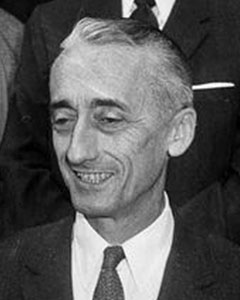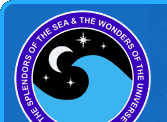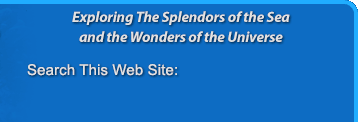
Jacques Cousteau
1910 - 1997
French naval officer, oceanographer, researcher, scientist, conservationist, filmmaker, and undersea explorer.
Internationally famous documentary host and creator of the Undersea World of Jacques Cousteau.
Inventor of diving devices and scuba devices such as the Aqua-Lung.
Jacques-Yves Cousteau was a French oceanographer, researcher, filmmaker, and undersea explorer. He was arguably the most famous undersea explorer of modern times. Cousteau was born on June 11, 1910 in Saint-André-de-Cubzac, Gironde, France. He was the younger of two sons and suffered from stomach problems and anemia as a young child. At age 4 he learned to swim. This started him on a lifelong fascination with water. He attended a boarding school in Alsace, France and then completed his preparatory studies at the Collège Stanislas in Paris. In 1930 he entered the French Navy and graduated as a gunnery officer. After graduation, he joined the French Navy's information service. He had a keen interest in photography, and this gave him an opportunity to shoot film at exotic ports-o-call in the Indian and Pacific Oceans. In 1933 Cousteau nearly lost his life in a serious automobile accident. During his rehabilitation, he began swimming in the Mediterranean Sea to strengthen his weak limbs. A friend gave him a pair of swimming goggles, which opened his eyes to the wonders of the sea. In 1937 he married Simone Melchior. They had two sons, Jean-Michel and Phillipe, both of whom would eventually join their father in his underwater expeditions.
During World War II, Cousteau and his family moved to the small town of Megève, near the Swiss border. Over the next few years he began his experiments in underwater research. He met a neighbor named Marcel Ichac who shared his passion for exploration. In 1943 they won the ex-aequo prize of the Congress of Documentary Film for the first French underwater film, Par dix-huit mètres de fond (18 meters deep). Later that year, Cousteau met a French engineer named Emile Gagnan. The two men experimented with compressed air cylinders and developed the first Aqua-Lung device which allowed divers to stay underwater for long periods of time. Cousteau also invented an underwater camera that could withstand the pressures of deep water. With these two new inventions, Cousteau made a new documentary film called Épaves ("Shipwrecks"). During the war, Cousteau joined the French Resistance movement, spying and documenting troop movements. He was later recognized for his heroic efforts and received several medals, including the Legion of Honor. After the war, he worked with the French Navy to clear underwater mines from shipping lanes.
In 1948 Cousteau accompanied divers and scientists on an expedition to the Mediterranean Sea to look for the wreck of the Roman ship, Mahdia. It was the first underwater archaeology operation using self-contained diving apparatus. It marked the beginning of underwater archaeology. In 1949 Cousteau left the French Navy and in 1950 he founded the French Oceanographic Campaigns (FOC). He leased a former British minesweeper which he converted to an oceanographic research vessel named Calypso. He needed to find a way to fund his research and realized that attracting media attention could help make people aware of what he was doing and why it was so important. In 1953 he published a book called The Silent World. It was later made into a film that won an award at the Cannes Film Festival. Over the next few years, he made expeditions to the Mediterranean, the Red Sea, and the Indian Ocean. In 1966 he launched his first hour-long television special, The World of Jacques-Yves Cousteau. Two years later, he produced his famous television series The Undersea World of Jacques Cousteau. This series ran for nine seasons. It captured the imagination of people all over the world and for the first time, brought the wonders of the sea into their living rooms. Cousteau also wrote several books, including The Shark, Dolphins, and Jacques Cousteau: The Ocean World. His books and television series brought him increased public support. In 1973 he founded the Cousteau Society to help raise awareness of the ecosystems of the oceans and the dangers posed by mankind.
In 1979 tragedy struck when Cousteau's son, Phillipe, was killed in a plane crash during a test flight. Cousteau continued to explore and research the oceans, and in the 1980s he produced more television specials. He was becoming concerned about how human activity was destroying the oceans, and these new television specials began to take on a more environmental message. His last film was made in 1989. It was a documentary about the Exxon Valdez oil spill in Alaska. In 1996 Calypso was rammed by a barge and sank in Singapore Harbor. Cousteau tried to raise money to build a new ship, but he died unexpectedly in Paris on June 25, 1997. His legacy includes more than 120 television documentaries and 50 books. The Cousteau Society, which he founded, has over 300,000 members today. Their goal is to help protect the oceans from the dangers of human activity. Cousteau's television specials enabled him to reach out to the public and created an entire generation of "armchair oceanographers".




